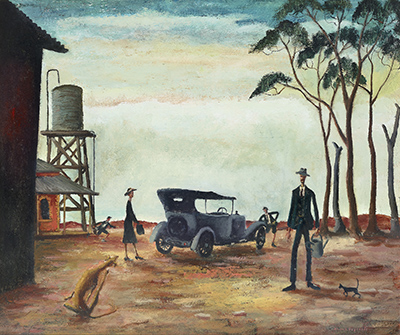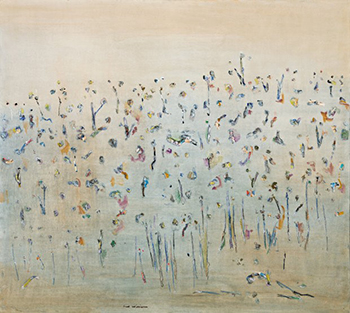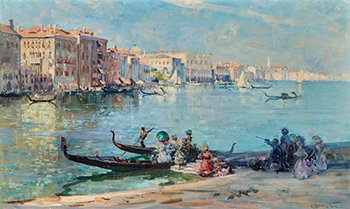'It’s a beauty': Drysdale's seminal work to test records
Australian Financial Review, Gabriella Coslovich, 24 September 2020
Auction house Deutscher and Hackett has consigned the year’s most expensive and historically significant painting, Russell Drysdale’s Going to the pictures, from 1941, which could set a new record for the artist when it goes under the hammer in November.
Estimated at $2.5 million to $3.5 million, the painting has been in the same family since it was first bought by the prominent Melbourne art critic and journalist, the late Clive Turnbull, at Drysdale’s landmark 1942 exhibition at Macquarie Galleries in Sydney.
DRYSDALE lowres.jpg

Russell Drysdale's Going to the pictures, 1941, could set a new
record for the artist, estimated at $2.5 million to $3.5 million
at Deutscher and Hackett on November 11.
Russell Drysdale's Going to the pictures, 1941, could set a new record for the artist, estimated at $2.5 million to $3.5 million at Deutscher and Hackett on November 11.
The current record for a Drysdale is $2.4 million (hammer) for the later and larger work Grandma’s Sunday Walk, from 1974, sold in 2017 by Mossgreen before the company’s spectacular collapse.
For reasons that transcend commerce, securing and selling Going to the pictures is the highpoint of Deutscher and Hackett’s co-executive director Chris Deutscher’s 45 years in the trade.
“It felt like the most important consignment I have ever made in my life,” Deutscher told Saleroom.
“Even though I was involved with the first $1 million sale of Arthur Streeton, Golden Summer, in 1985, this feels like a bigger moment, and maybe it goes to personal things, studying Drysdale and Moody’s Pub at school, my connection with my art school teacher, Ian Bow, and Clive Turnbull writing the book about him, it became emotional consigning it.”
Moody’s Pub, Drysdale’s celebrated painting of a quartet of lanky men idling outside an outback hotel (based on the Royal Hotel in Seymour, on the Hume Highway in Victoria), was also shown at the ground-breaking 1942 exhibition, and snapped up by the National Gallery of Victoria.
The family in Going to the pictures are similarly long-limbed, but dressed for an outing, smart in hats and suits, incongruous figures against the bleak and desiccated rural landscape. In the foreground a scrawny old greyhound scratches at its ears and a black cat walks towards the father who holds a watering-can used to fill the radiator of their old jalopy.
Russell Drysdale's Grandma’s Sunday Walk is the artist highest-selling painting at auction, selling for $2.4 million (hammer) at Mossgreen in 2017.
“It’s a beauty,” says Melbourne art critic Dr Christopher Heathcote, who curated an exhibition of Drysdale’s work at the TarraWarra Museum of Art, in Victoria’s Yarra Valley, in 2013-14. “This is a once-in-a-lifetime event. Without doubt it’s the most important Drysdale I have seen at auction.”
Drysdale’s 1942 exhibition laid the foundations of a new idiom that would mark the turning point not only of the artist’s career but also of Australian painting.
“Drysdale as a consciously modern artist takes the rural motifs of the old guard and uses them for his own purpose, preparing the way for artists after him, for Nolan and Boyd,” Dr Heathcote says. “This is where modern Australian art starts to go somewhere different and takes on the old guard and beats it at its own game.”
The motifs coined in 1942 will be repeated in Drysdale’s work in the years to come: gaunt dogs, gangly men, skeletal trees, and the signature pose of country people, languidly leaning against a car or doorway, or simply standing in the street, one hand on hip, elbow bent.
In his seminal book Rebels and Precursors: The Revolutionary Years of Australian Art, Richard Haese writes that Drysdale was painting “a little-known world on the fringes of Australian society”, and “reacting against the pastoral tradition that insisted upon lush painterly representations of a £20-an-acre country”.
Fred Williams’ Hillside at Lysterfield II, 1967 (estimate: $1.5 million to $2 million) is being auctioned at Deutscher and Hackett's Twenty Classics of Australian Art on November 11.
Williams lowres.jpg

Fred Williams’ Hillside at Lysterfield II, 1967
(estimate: $1.5 million to $2 million) is being
auctioned at Deutscher and Hackett's Twenty Classics
of Australian Art on November 11
Haese quotes Drysdale himself, who said in an interview in 1975: “Nobody seemed to be interested in the marvellous old towns and clapboard buildings and the kind of life that people led. They’re pretty monumental some of those people; they were people I’d known and I was terribly impressed with their stoicism in times of adversity.”
Drysdale’s daughter Lynne Clarke, who lives on Sydney’s northern beaches, was excited by the news that the painting was on the market for the first time in 78 years.
Howard Arkley’s Eastern Suburbs Pink Home, 1991, has an estimate of $700,000 – $900,000.
“It’s one of the early paintings and they really are wonderful and historically interesting too,” Clarke said.
Clarke, now 82, was barely four years old when her father painted Going to the pictures. The last time she saw the work was at the National Gallery of Victoria’s Drysdale touring retrospective of 1997-98. Interestingly, that retrospective was curated by Geoffrey Smith, now chairman of auction house Smith & Singer. Clarke will be heading to the auction viewing in Sydney for the chance to see the painting in the flesh once more.
“Let’s hope there will be a lot of people interested in this,” she said.
Clive Turnbull, who was appointed art critic for the Melbourne Herald by Sir Keith Murdoch in 1942, encouraged his readers to buy works by Drysdale (as well as those of Rupert Bunny, William Dobell and Peter Purves Smith) – and those who followed his counsel might be well pleased. Sir Keith (father of Rupert) also sought Turnbull’s advice when it came to buying art, and even though the two were politically misaligned, the media tycoon backed the critic and gave scope to his work.
Arthur Streeton’s Venice painting, Blue Lagoon, Fringed Round With Palaces, c.1908 (estimate: $400,000 – 600,000), will be auctioned at Deutscher and Hackett's Twenty Classics of Australian Art.
Going to the pictures goes under the hammer in Melbourne on November 11, at Deutscher and Hackett’s Twenty Classics of Australian Art auction, which will be live online, in keeping with the city’s COVID restrictions.
The sale will be the year’s biggest, with a total estimate of $10 million to $13 million, and, despite the auction title, 60 artworks have been consigned so far.
Streeton lowres.jpg

Arthur Streeton’s Venice painting, Blue Lagoon, Fringed
Round With Palaces,c.1908 (estimate: $400,000 – 600,000),
will be auctioned at Deutscher and Hackett's Twenty Classics
of Australian Art.
Aside from the Drysdale, three of the other “classics” include Fred Williams’ Hillside at Lysterfield II, 1967 (estimate: $1.5 million to $2 million), Howard Arkley’s Eastern Suburbs Pink Home, 1991 (estimate: $700,000 – $900,000) and Arthur Streeton’s Venice painting, Blue Lagoon, Fringed Round With Palaces, c.1908 (estimate: $400,000 – $600,000).
The Drysdale, though, is the jewel. In a career spanning more than four decades, Drysdale produced fewer than 300 paintings, making each major work that comes up for auction highly prized.